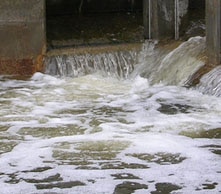Humic acid can assist in removing toxic metals and their ions from wastewater. Added to dissolved air flotation systems, humic acid assists in the removal of trace amounts of grease, oil, liquid organics and suspended matter. Used in conjunction with watersoluble polymeric flocculants, humic acid is a special coagulant aid for the removal of soluble organics. It can also be used as potential fluid loss additive in certain types of organic liquids to prevent seepage from lagoons.
In the chemical treatment of waste water, calcium hydroxide or sodium hydroxide are used to aid precipitation of metals. Adding humic acid improves the process and lowers the concentrations of undesirable ions below the permissible limit. As stated above, it is also possible to use humic acid to remove toxic metals from water. The residual level of toxic metals in waste water after such a treatment is lower than 0.03 mg/L.
The highest effect can be observed in the removal of:
















